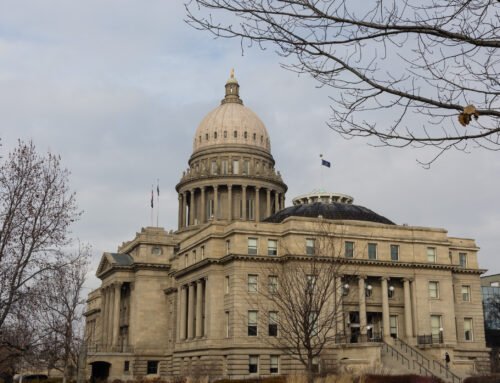The Idaho Legislature’s Joint Finance-Appropriations Committee visited a state prison, met with Micron executives and toured the former Idaho Transportation Department headquarters Thursday.
Although the Idaho Legislature is not in session, the budget-writing Joint Finance-Appropriations Committee and other legislative committees have conducted a series of meetings in Boise over the past two weeks as part of the annual process of gearing up for the legislative session that begins Jan. 8.
GET THE MORNING HEADLINES DELIVERED TO YOUR INBOX
Normally, JFAC meets on the third floor of the Idaho State Capitol in Boise in a room that served as the former home of the Idaho Supreme Court. But committee leaders scheduled Thursday’s field trip-style tours to give legislators who set the state budget a closer, tangible look at some of the facilities and programs that receive funding.
Normally, all JFAC and legislative committee meetings are streamed live to the public via Idaho in Session using microphones and video equipment set up throughout the Statehouse. But state officials weren’t able to stream JFAC members’ visits Thursday when they were away from their normal committee room.
Two journalists with the Idaho Capital Sun followed JFAC’s tour Thursday to report on who the legislators met with and what they saw.
Idaho legislators on JFAC visit Southern Idaho Correctional Institution
After boarding a purple bus idling outside the Statehouse, JFAC members and some Legislative Services Office staff traveled to Kuna to visit the East Dorm of the Southern Idaho Correctional Institution in Kuna.
At the prison gate, legislators met Idaho Department of Correction Director Josh Tewalt, who led the legislators inside the prison. Tewalt told the legislators the East Dorm is a minimum-security “incentive” unit. There, inmates have more freedom and more ability to make choices for themselves. They can make some of their own meals, do their own laundry, watch TV and move throughout the dorm in a common group space. Half of the inmates at the East Dorm leave the prison during the day to work and are paid, Tewalt said. Some of the money they earn stays with the prison to pay for their program and some of the money inmates can keep, spend or send home to family. Tewalt told legislators some inmates work every day in the community, return to the prison to sleep and can earn up to $500 a week.
Throughout the visit, Tewalt asked legislators to rethink the traditional perceptions of prison and corrections – asking legislators to think in terms of coaching and rehabilitation instead of punishment.
Tewalt told legislators that many people initially balk at seeing the East Dorm with its couches and kitchens and the ability for inmates to move from room to room across a building that looks more like a high school than a prison.
Tewalt said many people’s minds change once they learn it is less expensive to build, costing between $500 and $600 per square foot instead of $1,100 to $1,200 per square foot for concrete, steel and higher security fittings. Because inmates have to earn the chance to live in the East Dorm, the facility also helps prepare inmates for being released by taking accountability for the choices and decisions they make inside.
“This isn’t just good policy, it’s also really good math,” Tewalt said.
Unfortunately, Tewalt told legislators more than 1,000 Idaho inmates are housed in beds in a higher security clearance than is needed because the state doesn’t have enough minimum-security facilities like the East Dorm.
When considering corrections and prison budgets, Tewalt urged legislators to support adding the “right beds.”
During the visit, legislators visited common areas inside the dorm, looked inside one of the dorm rooms and spoke with two inmates. One of the inmates told legislators that he is serving a 15-year sentence for drug trafficking. He works, is studying to obtain a certificate in video editing and has been able to earn money to send to his son to buy wrestling shoes. The inmate told legislators he realizes the burden his prison sentence has placed on his family. As far as he is concerned, his re-entry process has already started inside the East Dorm.
“Every day I wake up and I have one goal and that is to get back to my family,” the man told legislators.
Rep. Wendy Horman, R-Idaho Falls, said the experience was eye-opening.
“The benefit of visiting the actual sites is to see with our own eyes the effects of the decisions we have made,” Horman, one of JFAC’s co-chairs, said. “So, at the prison, we are seeing the impacts that’s having on the lives of residents there and how it is preparing them in a much better way to be reintroduced to our society.”
Idaho legislators meet with Micron executives about expansion plans
After leaving the prison, legislators traveled by bus to Micron’s Boise campus on Federal Way.
The committee members met with Executive Vice President and Chief People Officer April Arnzen, Senior Director of U.S. Expansion Planning Jeff Binford and Buddy Nicoson, a Micron vice president.
Anrzen, Binford and Nicoson gave legislators an overview of Micron’s $15 billion expansion plan that includes building a new memory making fabrication facility – or fab – in Boise.
Micron executives also discussed the company’s 20-year, $100 billion “megafab” expansion plan near Syracuse, New York.
After a legislator asked why Micron leaders chose New York and not Idaho for the site of the larger megafab, Micron officials said the New York site was already well prepared, infrastructure was in place, New York officials offered significant incentives and the ground was essentially turn-key ready.
Need to get in touch?
Have a news tip?
Arnzen described Idaho as Micron’s crown jewel and said the Idaho expansion project is expected to create 2,000 new jobs at Micron here as well as 15,000 other local jobs connected to the expansion project and construction of the new fab.
During the briefing, Arnzen told legislators that a quality education system, workforce training programs, infrastructure and expanded child care programs are vital components of business development and being able to recruit and hire a skilled workforce that Micron demands.
Arnzen highlighted Micron’s partnerships with more than a dozen colleges and universities in the Northwest and its apprenticeship and internship programs.
After the briefing on Micron’s expansion plans, JFAC members participated in a short tour of one of Micron’s buildings, stopping for photos near Micron’s wall of fame that displays information for more than 60,000 patents for inventions the company’s employees have received. The tour also allowed legislators to peek through the glass into a high-tech factory floor as machines raced across the ceiling to collect and deliver materials.
Micron executives also discussed the CHIPS Act, which provides new funding and incentives designed to support semiconductor research and development. Congress passed the act last year and President Joe Biden signed it into law. But Idaho’s entire Republican congressional delegation – Reps. Mike Simpson and Russ Fulcher and Sens. Jim Risch and Mike Crapo – voted against the CHIPS Act in July 2022
Idaho budget writers express frustration with sale of former Idaho Transportation Department headquarters
During the last stop of the day Thursday, legislators on JFAC visited the Idaho Transportation Department’s former headquarters on State Street in Boise.
After the headquarters building flooded and was contaminated, the Idaho Transportation Department board voted unanimously to declare the entire 45-acre campus as surplus property, which paved the way for the state to sell it, the Idaho Press reported.
In September, the state sold the property to a joint venture between The Pacific Companies, The Hawkins Companies and FJ Management, one of the companies that owns Pilot Flying J convenience stores, for $51.7 million, Idaho Department of Administration Director Steven Bailey told legislators Thursday.
In connection with the deal, the Idaho Transportation Department is requesting $56.3 million in the fiscal year 2025 budget to build a new central operations complex near other state offices on Chinden Road. The Idaho State Historical Society, which also had facilities located at the old Idaho Transportation Department property that the state sold, has already received $15 million in the fiscal year 2024 budget for a new building. The Idaho State Historical Society is also requesting $6.2 million in the fiscal year 2025 budget for shelving to store irreplaceable artifacts, government records and collections in the new building.
Legislators from both political parties expressed frustration that they were not part of the decision making chain when it came to surplusing and selling off the Idaho Transportation Department campus. Some legislators described the piece of land, which is located near Esther Simplot Pond just outside of downtown Boise, as a piece of prime real estate the likes of which the state could never afford to replace or buy back.
Even though the sale of the building will bring in $51.7 million as long as the deal closes, several legislators were frustrated that even though they did not have a say in selling the property they are being asked to approve more than $70 million for the construction of new facilities for state agencies that are vacating the old site.
“It’s very expensive,” Sen. Dave Lent, R-Idaho Falls, said during the meeting.
“This just seems really interesting that we are stuck paying a bill because of a decision of a very small (Idaho Transportation Department) board,” Sen. Janie Ward-Engeking, D-Boise, added.
Idaho Capital Sun intern Brydon Black contributed to this report.






Leave A Comment